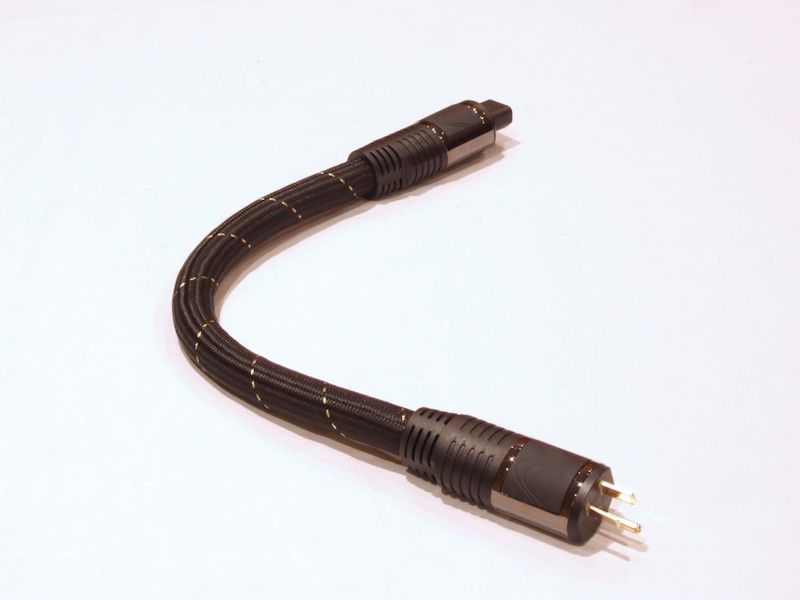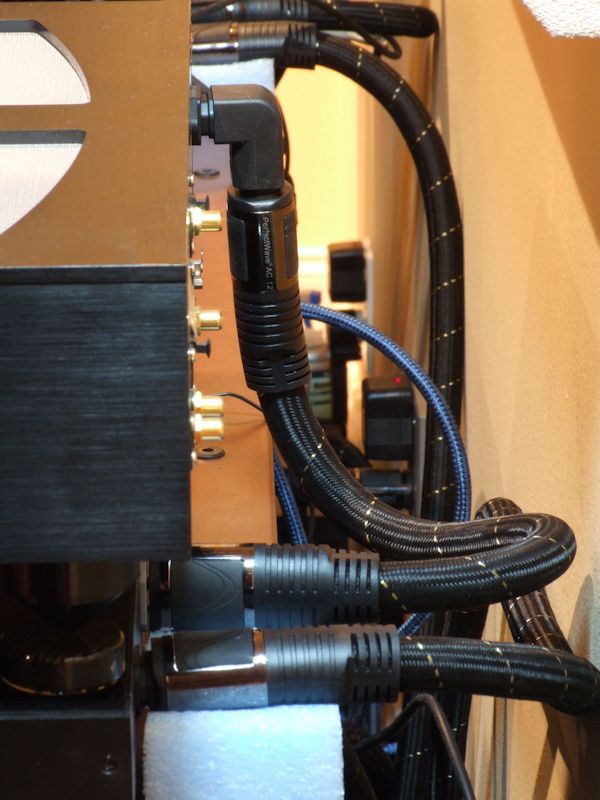PS Audio PerfectWave AC-12 Power Cord
Comments
-
Paul J Wright wrote: »Hi, DarqueKnight,
Hi Paul. Welcome to the forum.Paul J Wright wrote: »Have you tried the following setup:
wall---> AC-12 ---> power amp. (int. or monoblock)
Yes.Paul J Wright wrote: »wall ---> AC-12 ---> preamp.
Yes.Paul J Wright wrote: »wall ---> AC-12 ---> DACPaul J Wright wrote: »wall ---> Premeir SC ---> CDTransport
With my SACD player, not with a separate transport or DAC. The AC-12 sounded better between the wall and the SACD player. The Premier SC sounded better between the SACD player and the AC regenerator.Paul J Wright wrote: »Do you think too many AC-12s will sound bad?
I don't know. The only bad experience I have had with the AC-12 was when I put it between the wall and my AC regenerator.Proud and loyal citizen of the Digital Domain and Solid State Country! -
DarqueKnight wrote: »AC-12 On Turntable Motor Power Supply
Apparently, the over 1000 hours of use of this Premier SC made a world of difference. I left it in place because it was providing Such Good Sound.
Hi DarqueKnight, thank you for your reply.
Do you think the "after-1000-hrs.-Premier SC" can outperform AC-12 generally?
thank you!:rolleyes: -
Paul J Wright wrote: »Do you think the "after-1000-hrs.-Premier SC" can outperform AC-12 generally?
Generally...no.Proud and loyal citizen of the Digital Domain and Solid State Country! -
DarqueKnight, thank you!
you help me to save $$$...
I will focus on AC-12 only. -
DarqueKnight wrote: »Generally...no.
thank you! -
Paul J Wright wrote: »DarqueKnight, thank you!
you help me to save $$$...
I will focus on AC-12 only.
The AC-12 is a much better power cord for much less money. However, there may be situations were the Premier SC will sound better. The only time I experienced this was comparing the AC-12 and Premier SC between a component and an AC regenerator. I forwarded this result to PS Audio and they said they could not duplicate it. I also posted my results on the PS Audio forum and no one there said they experienced this.
Please be aware that PS Audio power cords, especially the AC series cords, are widely counterfeited. Make sure you buy from a trusted source.Proud and loyal citizen of the Digital Domain and Solid State Country! -
DarqueKnight wrote: »I forwarded this result to PS Audio and they said they could not duplicate it. I also posted my results on the PS Audio forum and no one there said they experienced this.
"could not duplicate it."
what do you mean?
could not use both Premier SC and AC-12 at the same time in one system?
thanks -
Paul J Wright wrote: »"could not duplicate it."
what do you mean?
could not use both Premier SC and AC-12 at the same time in one system?
In my 2 channel audio system, when I used AC-12 power cords between a PS Audio Power Plant Premier AC regerator and audio components or when I used AC-12 power cords between a PS Audio P10 AC regenerator and audio components, there was a loss of sound quality. I experienced the same thing in my home theater system when I tried to use AC-5 power cords between either a PS Audio AC Power Plant Premier AC regenerator or a PS Audio P10 AC regenerator and audio components.
PS Audio said they did not experience a reduction in sound quality when AC series power cords were used between an AC regenerator and audio components.Proud and loyal citizen of the Digital Domain and Solid State Country! -
DarqueKnight wrote: »In my 2 channel audio system, when I used AC-12 power cords between a PS Audio Power Plant Premier AC regerator and audio components or when I used AC-12 power cords between a PS Audio P10 AC regenerator and audio components, there was a loss of sound quality. I experienced the same thing in my home theater system when I tried to use AC-5 power cords between either a PS Audio AC Power Plant Premier AC regenerator or a PS Audio P10 AC regenerator and audio components.
thank you DK's reply!
did you try the below setup?
wall ---> AC-12 ---> AC Regenerator
AC Reg. ---> AC-12 ---> CD player/Dac/Preamp etc.
wall ---> AC-12 ---> power amp.
thank you! -
Paul J Wright wrote: »did you try the below setup?
Yes to all three questions. All three have been previously addressed either in my review or in answers to your questions.Paul J Wright wrote: »wall ---> AC-12 ---> AC Regenerator
This is what I have now.Paul J Wright wrote: »AC Reg. ---> AC-12 ---> CD player/Dac/Preamp etc.
I have already answered this.Paul J Wright wrote: »wall ---> AC-12 ---> power amp.
Yes. This is what I have now. This is discussed in the review.Proud and loyal citizen of the Digital Domain and Solid State Country! -
thz for DK's reply and insightful review.
.....another issues.....
I am using P-1000 (PS Audio AC regenerator)! I found it will distort the sounding and diminish a bit of dynamics of sound. Do you think so? -
Paul J Wright wrote: »thz for DK's reply and insightful review.
.....another issues.....
I am using P-1000 (PS Audio AC regenerator)! I found it will distort the sounding and diminish a bit of dynamics of sound. Do you think so?
The P-1000 has a continuous current rating of 7 amps and a peak current rating of 10 amps. Therefore it is highly likely that some high current power amps will experience compression of dynamics when connected to the P-1000. In comparison, the PS Audio P10 AC regenerator has a peak current capacity of 70 amps and even this is not enough for some power amplifiers.Proud and loyal citizen of the Digital Domain and Solid State Country! -
DarqueKnight wrote: »The P-1000 has a continuous current rating of 7 amps and a peak current rating of 10 amps. Therefore it is highly likely that some high current power amps will experience compression of dynamics when connected to the P-1000. In comparison, the PS Audio P10 AC regenerator has a peak current capacity of 70 amps and even this is not enough for some power amplifiers.
DK, wow, you really know everything about PS Audio's products....! I can't believe it!
In fact, I didn't connect the power amp. to P-1000. P-1000 serves the CD transport and the Dac only.
Thank you! -
Paul J Wright wrote: »DK, wow, you really know everything about PS Audio's products....!
No, I don't.Paul J Wright wrote: »In fact, I didn't connect the power amp. to P-1000. P-1000 serves the CD transport and the Dac only.
I am surprised that the P-1000 was stressed by only two source components.Proud and loyal citizen of the Digital Domain and Solid State Country! -
My initial trials in 2009 with AC-12 power cords in my two channel audio system were not entirely successful:DarqueKnight wrote: »To summarize: In my system, AC-12's between the wall and a component sounded good, but AC-12's between the [Power Plant Premier] AC regenerator and a component sounded bad.
The Power Plant Premier AC regenerator was replaced with a P10 regenerator in November of 2011. I recently conducted trials with AC-12 power cords between the P10 regenerator and the source components and preamps. Those trials were successful.
Figure 11. Cute! A "baby" 1/2 meter AC-12 was installed between the SACD player and its PowerBase
isolation platform.
Figure 12. I wasn't sure that a 1/2 meter AC-12 would work due to the stiffness of
the cord and the bend radiuses required, but I wanted to try it because the 1/2
meter AC-12s were on closeout for $199.99 and free shipping.
Replacing the Cary Audio CD 306 Pro Version SACD player's 1 meter Premier SC power cord with a 1/2 meter AC-12 resulted in more tactile sensation, heavier images, and more "growly" bass. However, there was a small loss of overall clarity and detail, but not the severe veiling that was heard when the former Power Plant Premier was used.
The new AC-12s were burned in on the JuiceCyclone power cable conditioner for 24 hours continuously at 10 amps, then burned in for another 24 hours continuously on the Audiodharma Cable Cooker.
After burn in the replacement of the SACD player's Premier SC power cord with an AC-12 resulted in the following improvements:
1. Apparently louder sound level.
2. More overall clarity and detail, especially micro-details in the center.
3. Enhanced depth.
4. More image weight and tactile sensation.
5. More bass articulation, weight, detail, and growl, especially micro-growls.
6. More holographic imaging.
These improvements increased as the Premier SC cords were replaced on the SACD player's PowerBase isolation platform and then the Pass Labs XP-30 preamp.
For the analog source, I did not do incremental replacements because it would have required pulling my very heavy audio cabinet from the wall an additional three times to replace the power cords for the Pass Labs XP-25 phono preamp, turntable PowerBase isolation platform, and turntable motor power supply. A listening session, with detailed notes, was done with the analog electronics powered by Premier SC power cords and then another listening session was done with all the Premiers replaced with burned in AC-12s.
In addition to listening evaluations, stroboscopic speed measurements of the turntable's motor speed were done with the Premier and AC-12 power cords. With each cord, there was no measurable plus or minus speed drift. With the Power Plant Premier and AC-12 trials in 2009, the turntable motor ran 0.08% slow. In the 2009 trials, when the motor was connected to the wall with an AC-12 the motor ran 0.08% fast.
Replacing the three analog side power cords with AC-12s resulted in the all of the improvements cited above, with the addition of a slightly "hot" high end. There was a bit of added sizzle to drum brushes, ride cymbals and female voices. The hot high end took five hours of play time to settle down into silky smoothness.
From most to least improvement by component with the AC-12 power cords:
1. Pass Labs X600.5 power amplifiers.
2. Pass Labs XP-30 preamplifier.
3. Pass Labs XP-25 phono preamplifier
4. Cary Audio CD 306 Pro Version SACD player
5. PS Audio P10 AC regenerator
6. PS Audio PowerBase for SACD player.
I did not evaluate the power cord replacements for the turntable's motor power supply and PowerBase separately, therefore I could not rank them.
While my audio cabinet was pulled out from the wall, I took the opportunity to place stiff foam blocks (just like the ones in figure 12) under the power cord plugs connected to the P10. That relieved a lot of strain off the plug and receptacle. I should have done that when I initially installed the P10 and I should have done it for the Power Plant Premier.Proud and loyal citizen of the Digital Domain and Solid State Country! -
Cute! A "baby" 1/2 meter AC-12 was installed between the SACD player and its PowerBase isolation platform.
That cord is cute.Political Correctness'.........defined
"A doctrine fostered by a delusional, illogical minority and rabidly promoted by an unscrupulous mainstream media, which holds forth the proposition that it is entirely possible to pick up a t-u-r-d by the clean end."
President of Club Polk -
Where can one score a .5 AC-12. PS Audio has them but same price as 1m : (For Sale 2019:
Tortuga Audio LDR passive preamp
Decware EL34 amp
Allnic H-1201 phono
Zu Union Cubes
iFi iDSD DAC, .5m UBS, iFI Gemini cable, Oyaide Tunami XLR 1.3M, Oyaide Tunami Speaker wire 1.5M, Beyerdynamic DT1990 headphones, PS Audio P3 power center

